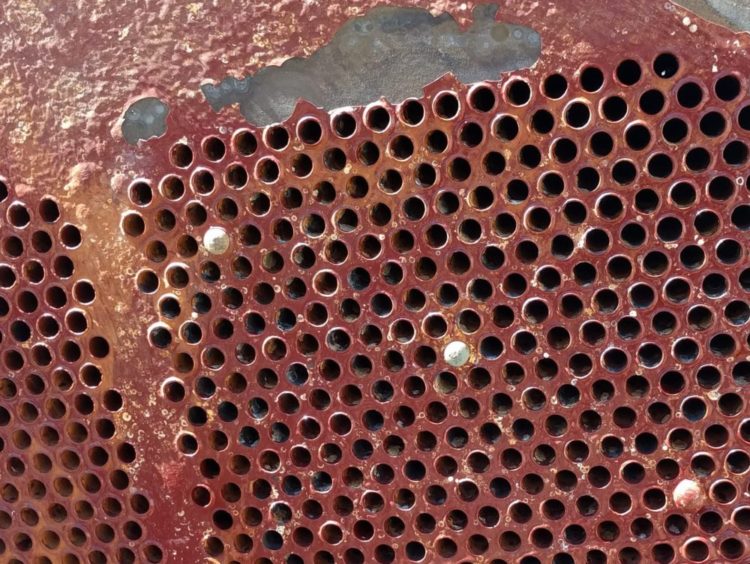
HeatX is nanostructured to create a passivating layer that repels fouling, water, and oils, while protecting against corrosion
CORROSION
Corrosion results from chemical reactions that naturally occur externally and internally in heat exchangers. Corrosion involves the deterioration of metal tubing and components: according to NACE International, corrosion is “the destruction of a (metal) or its properties because of a reaction with its environment.”
Corrosion ultimately causes severe damage to metals that can become very costly to repair.
Shell-and-tube heat exchangers can suffer wall loss on both the inner (ID) and outer diameter (OD) surfaces to a degree of threatening the operation reliability of the heat exchanger. Tubes can often suffer corrosion on both ID and OD surfaces in the form of pitting corrosion.
Current Approaches
The most commonly-used method of corrosion prevention is through water monitoring, or by paying close attention to the substances that are used in accordance to the heat exchanger’s makeup. There are various coatings and epoxies; however, long-lasting prevention has not been fully accomplished due to issues with durability, an increased heat transfer coefficient, and high costs. Experiments with adding zinc anodes to the heat exchanger bonnet have been tested, but due to the overwhelming amount of metal lost, zinc anodes need to be inspected regularly and replaced as required.
HeatX Corrosion Protection
HeatX has been demonstrated to significantly reduce the frequency of costly maintenance operations, and extend the overall “useful life” of assets. HeatX has been qualified to show corrosion resistance, abrasion resistance, and chemical compatibility with both water, hydrocarbon, and mixed phase conditions.
The water based formulation can be flexibly applied to unprepared corroded surfaces and still achieve full performance. In addition, the overall thickness of the HeatX coating is less than 4 mil, and does not affect the overall heat transfer performance.
Results of corrosion
- Thinning of exchanger tubes from chemical reactions
- Heat exchanger equipment failure
- Pollution to the environment caused from mixing contaminations
- Loss of productivity leading to more downtime
- Increase of energy consumption and maintenance expenses
- Exposing fresh metal to further attack
Benefits of HeatX
- Water-and-oil compatible coating material allows for use in mixed-phase and oleic systems.
- Resistant to abrasive wear due to particulate contaminants. Capable of surviving intake silt from unprocessed, unfiltered sea water.
- Long lasting chemical resistance and compatibility with water and hydrocarbon-based fluids.
- Minimize downtime and maintenance cost
- Long-lasting results that extends the life of the heat exchanger
FOULING
HeatX exchanger fouling can result in major performance and operational issues. Over time, tube surfaces become covered by naturally built-up deposits of debris and microorganisms that form an insulating layer of film. As the overall heat transfer surface becomes layered with particles such as biofilm, dirt, sand, etc. an increase in energy consumption is required to compensate for the heat transfer inefficiency. Eventually the heat exchanger must be taken offline to be serviced, which can be very costly over time. Types of fouling include biological, chemical, deposition, corrosion, and precipitation fouling.
Current Approaches
Various strategies have been developed to reduce fouling, however, while many anti-fouling solutions have been successfully demonstrated in the laboratory, they are typically expensive to enact, decrease heat transfer performance, are not durable, and fail to demonstrate the same benefits under industry comparable process conditions. Regular cleaning and maintenance rounds are industry standard, but impact operations and are costly over time.
Foul Mitigation
Due to the extremely low surface energy of HeatX treatment, the treated surface becomes very slick and minimizes the ability of fouling to bind on the surface and grow. HeatX is non-biocidal, meaning is doesn’t contain harmful compounds that aim to kill microorganisms. These biocides are commonly found in older anti-fouling coatings. Biocides often have negative environmental impacts on the surrounding ecosystem – HeatX, on the other hand, is environmentally friendly and non-toxic once cured.
HeatX is a functionalized surface treatment with hydrophobic and oleophobic properties (high water and oil repellency). The water-based treatment can be applied to a variety of form factors including the interior of tubulars in both straight & U-tube and shell & tube configurations, as well as plate & frame heat exchangers. The unique surface properties of HeatX offer extremely low adhesion strengths to both water- and oil-based materials, resulting in drag reduction and improved fluid flow.
Results of fouling
- Increase in energy consumption
- Frequent cleanup
- Loss of productivity leading to more downtime
- Pollution to the environment
Benefits of HeatX
- Extreme thinness of the coating (<2 mil DFT), allows for minimal change in exchanger thermal efficiency.
- Functional up to 400°F, and stable under thermal cycling
- Reduces pumping costs by lowering pressure drop across the exchanger
- Minimizes downtime and maintenance costs by reducing cleanings and maintenance days
- Long-lasting results that extend the lives of heat exchanger units
EROSION & PITTING
Erosion damage can occur when scale particles break loose and subsequently impinge upon other surfaces. It can also occur from silt, corrosion, or anything else moving past the surface under high shear conditions.
Erosive wear accelerates when protective films deteriorate due to mechanical vibrations, excessive velocities, and suspended solid particles impact surfaces. The loss of material may lead to potentially harmful problems, both physically, with the heat exchanger unit, and in terms of costs and down-time. Most heat exchanger erosion problems occur at exchanger entrances and within the chambers of the unit. Erosion is also commonly found where baffles and tubes meet.
Current Approaches
Excess fluid velocities, above and beyond manufacturer recommendations can will likely cause erosion damage as metal is worn away from the tubular surfaces. This can happen on either shell or tube side of a heat exchanger. If any corrosion already exists on the unit, erosion may be accelerated, exposing the underlying metal to further attach without a protective top cover.
There have been several attempts to use coatings to combat erosion within heat exchangers. However, each of these past coatings had trade-offers in terms of cost, durability, and insulation of the heat transfer performance itself.
Erosion Protection
HeatX imparts wear and erosion resistance in fluids with particulate contamination. The final resulting surface is inert to both water and oil-based liquids. HeatX can be applied to in-service exchanger tubes as part of a refurbishment operation that can remove existing scale and corrosion, and prevent any further damage. HeatX has excellent flow properties, allowing for complete coverage of straight and U-tube configurations to 100% NACE standards.

